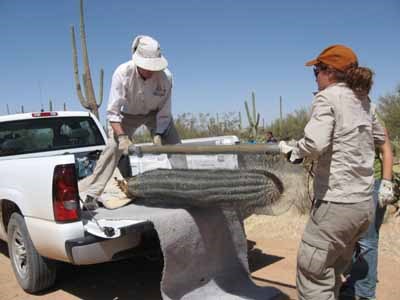Tantalizing Tucson
Odometer 64383
Trip 13 miles
 |
| Main entrance to the DBG |
Ironically, our first exploration was to visit the Desert Botanical Garden in Phoenix! I know, we just left there, but our friends Marla and Kermit were willing to do the drive and they have a very comfortable touring car.
Desert Botanical Gardens is for those who think the desert is nothing but dirt and tumbleweeds. They have showcased thousands of species of cactus, trees, shrubs and flowers on a 55 acre site.
There are 5 main loop trails with several sub-trails all with a theme. All in all, I would estimate about 2 miles, of really beautiful scenery!
 |
| A very necessary trail map comes with your admission. It is keyed with signs and colors to the trail system |
We checked out the Wild Flower Loop and then joined up at the main Discovery Loop and dropped off the trail at the Patio Cafe where we took time out for some hot coffee and brownies!
 |
| Wildflower Pavilion on the Desert Wildflower loop |
There is nothing here that wouldn't grow just fine in the surrounding desert, but the placement and arrangement, make these gardens spectacular.
 |
| Steel plant storage box used by developers |
I took the photo shown on the right, because there is a cool story behind this set-up. In 1980 there was a movement by several municipalities to ban the practice of dozing the plants off the desert before building. Phil Hebets saw an opportunity and designed these steel skips for builders to use to excavate and store the native plants for re-planting when the landscaping is ready.
Since desert plants grow so slowly, this is also a very intelligent way to save mature trees, cacti and shrubs for your new homesite.
While it is illegal to remove plants from public land in the desert, there are many plant nurseries in and around Tucson, and Phoenix that grow and sell just about any desert plant you may want. Many ranchers supplement their income by selling plants- including very tall saguaros.
Surprisingly very little of the root is necessary for a successful transplant, however, the plant must be stabilized until new roots have grown.
There is a night show here called the Electric Desert, but we weren't going to stay til dark to see it. Someone else will have to blog on the lights and music. I liked this place because they had signs that let you know what genus and specie each plant was. The genus name for prickly pear is "Opuntia" -(Oh-punch-ya) if that doesn't say keep away what does?
Now for something a little closer to home, we decided to visit the Arizona State Museum on the University of Arizona campus.
Since desert plants grow so slowly, this is also a very intelligent way to save mature trees, cacti and shrubs for your new homesite.
 |
| Photo courtesy of NPS |
While it is illegal to remove plants from public land in the desert, there are many plant nurseries in and around Tucson, and Phoenix that grow and sell just about any desert plant you may want. Many ranchers supplement their income by selling plants- including very tall saguaros.
Surprisingly very little of the root is necessary for a successful transplant, however, the plant must be stabilized until new roots have grown.
 |
| Garden path with luminary ready for a night time show |
Now for something a little closer to home, we decided to visit the Arizona State Museum on the University of Arizona campus.
 |
| Joan enjoys the ancient pottery on display at the Arizona State Museum in Tucson |
The room pictured above is filled with what I thought were some incredibly beautiful pots both contemporary and ancient, but as I worked my way to the back of the room, I saw the entrance to another room that was a climate controlled "vault" for the oldest and most valuable finds. The vault was off limits to any but authorized researchers- and even though I showed them my Bi-Mart card I couldn't get them to let me in.

This pot caught my eye. It is what archaeologists think is a seed jar dated to the years 50- 500 CE (around one thousand five hundred years old) and is from here in the Tucson Basin!


Another big surprise for me was the revelation that a wooly mammoth from the Pleistocene era was found near Naco, Arizona south of here. A local rancher noticed the tips of the tusks sticking out of a wash, and called archaeologists from the University of Arizona


Another surprise awaited the team as they excavated the carcass, they found not one, but two spear points nestled in the ribs! Our ancestors from 13,000 years ago, had hunted and killed this mammoth!


No blog post would be finished without a beautiful sunset.
Your Traveling Friends
Jeff and Joan


Comments
Post a Comment